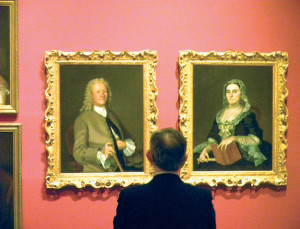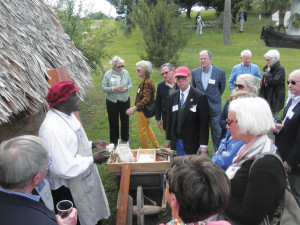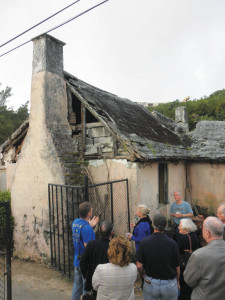Discovering Bermuda
EVENTS > SYMPOSIA
In Review: The Decorative Arts Trust Spring Symposium, 2014
If you were unable to join us in Bermuda, yet have a desire to visit this magnificent island, our experience during the symposium in March should provide all the encouragement you need to make your travel arrangements as soon as possible. The Bermudians we encountered at every turn embodied the definition of gracious hospitality, and we were treated like visiting dignitaries.
The program’s content was excellent. We heard first-rate lectures by Bermuda’s leading historians and decorative art authorities, including Dr. Edward Harris, archaeologist and director of the Bermuda Maritime Museum; Hugh Douglas, a silver specialist; and Tim Rogers, an architectural historian. The participation of two American scholars also proved to be a tremendous boon. Michael Jarvis, an archaeologist at the University of Rochester, who has devoted his academic career to Bermuda’s fascinating history, delivered two top-notch presentations, and Keith Adams, a collector and scholar from New Castle, DE, shared his extensive knowledge of the design and construction of Bermudian furniture.
The opportunity to tour the full swath of the island and soak in four centuries of Bermudian history was advantageous, from the winding narrow streets of St. George’s, to the rich collection and stunning vistas at Verdmont, to the bluster of the Naval Dockyard. We were fortunate to have been accompanied throughout the trip by Peter Frith of the Bermuda National Trust, whose deep knowledge and booming voice kept us engaged and on track at each site. We offer a few snippets to characterize the rich and varied nature of the experience.
The Portraits of Joseph Blackburn
The talented English portraitist Joseph Blackburn spent a brief amount of time in Bermuda (1752–1753) but received the extensive patronage of the island’s mercantile elite before moving on to Newport, Boston, and Portsmouth. We had the opportunity to examine more than a half dozen of his works in various public and private collections and admired his technique in comparison to contemporaries working in colonial America such as Feke and Smibert.
More significant than his renderings of Bermuda’s well-heeled families, however, is their remarkable survival in original carved and gilt rococo frames. While the source for these exceptional items is unknown, they were likely imported from one side of the Atlantic or the other and testify to the close connections Bermudians maintained to England and her American colonies through familial ties and business connections. The portraits shown here are from the Bermuda National Gallery and depict Mary and John Harvey. Additional examples of Blackburn’s work were encountered at the Tucker House, Verdmont, and in a private collection.
The Gardener’s Cottage at the Fairmount Southampton
We had the unexpected pleasure of adding an impromptu visit to see a seventeenth-century Bermuda house prior to the Sunday morning session. Two dozen hearty souls ventured down the hill from the Fairmount Southampton with Michael Jarvis leading the way. Known as the Gardener’s Cottage, this abandoned and dilapidated structure has been the subject of much study and discussion of late, and its poor condition created a rare opportunity to examine the framing of the house, roof, and chimney. Having spent Friday afternoon on St. David’s Island with local artisan Larry Mills, an expert on the construction of Bermuda stone houses, we were able to put some of that new knowledge to good use.
Following an architectural investigation by Ed Chappell of Colonial Williamsburg, Brent Fortenberry, an archaeologist from Boston University, recently conducted an extensive excavation of the site’s cellar. Based on architectural and documentary evidence, the house is thought to date from the last quarter of seventeenth century. Artifacts recovered during the dig suggest that the house’s cellar was occupied by enslaved African-Bermudians from 1680–1700 and then 1760–1830. With the renewed interest in the significance of the structure and site, the Bermuda preservation community is hoping that the remnants can be salvaged and reconstructed elsewhere for the benefit of future visitors and historians.
Our Curtis Student Scholarship Recipients
With the generous assistance of two dozen of our Bermuda participants, we were able to award Dewey Lee Curtis Student Scholarships to two graduate students, thereby allowing them to participate in the symposium. We were joined by Kate Hughes, from the Sotheby’s Institute of Art’s American Art Program, and Jackie Killian, a second-year McNeil Fellow in the Winterthur Program in American Material Culture, whose thesis research is reported in this newsletter. Kate and Jackie raved about the opportunity and praised its value to their academic studies and career plans. Kate was particularly impressed by the chance to meet “fellow scholars at various points in their careers, all so willing to share their knowledge and advice, [which] was wonderfully motivating, and gave lots of inspiration.”
N.b. If you were unable to join us in Bermuda for the symposium but have a desire to explore the island’s rich history at a future date, we strongly encourage you to start planning your own expedition. Whether with a group of five or fifty, Peter Frith and his colleagues at the Bermuda National Trust will ensure that you see the top sites. We hope you will have an opportunity to visit this marvelous and historically significant island in the near future.





